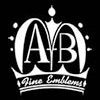A-B is a longtime designer and manufacturer of emblems
Please take advantage of our many years of experience by using Design Tips from A-B Emblem to create your custom embroidered patch.
Every Stitch Counts! We can help you create the perfect patch by using the design tips provided below. A-B Emblem guarantees customer satisfaction with every purchase. Our goal is to make sure you receive the best custom emblem possible.
Bold Is Better
Embroidery using bold letters and strong design elements looks the best.
Strong Color Contrast Is Ideal
High color contrast is preferable to a light-on-light or a dark-on-dark color scheme. Please consider this if visibility is a concern with an intricate design. However, there are two exceptions to this rule: black-on-white and white-on-black. Either situation can result in poor quality embroidery coverage.
Lettering – Minimum Size ⅛″
Lettering smaller than ⅛″ of an inch compromises legibility. Please note the minimum size is based on the lower case letters – if you have both upper and lower case!
Open Block Lettering Is More Legible
Narrow and condensed typefaces do not embroider well. Tall skinny fonts are to be avoided. Squat bold fonts (but not extra bold) are best. Other typefaces that embroider well include simple script, bold fonts with serifs, and freehand styles. If you are using a stylized font, look at the small details, like the inside of the lower case letters. Above all, it’s important to keep these areas open so they will embroider cleanly.
Blank Spaces Are Boring
Eliminate the blank space! Great ways to do this include making graphic elements more prominent, extending or increasing the text size, and introducing other graphic elements.
Choose A Complimenting Border
Overlock Edge Border aka Merrow® ravel-proof
For the most classic patch look – use an overlock edge border! Most simple patch shapes can have our classic Merrow® ravel-proof overlock edge border applied to them. The border is added after the patches are die-cut. An overlocked edge is ⅛ inch thick. For the best results, keep your embroidered detail at least ¹⁄₁₆ of an inch away from the overclock edge.
Hot Needle Cut aka the Contour Sealed Patch
A Hot Needle Cut Border is available on any patch. It’s embroidered with the design rather than being added later. A Hot Needle Cut Border with a Heat Seal backing is called a Contour Sealed Patch. It has a low profile edge and can be used as an alternative to Direct Embroidery. A Hot Needle Cut border can be as thin as ¹⁄₁₆ of an inch along the outer edge of the patch. Try to leave ¹⁄₁₆″ of space between elements or letters running parallel to the border.
Specialty Borders
Here’s a short rundown of the many options! A Laser Contour leaves a small margin of non-embroidered material around the entire patch. While using a Handcut or Diecut with a Raw Edge provides a vintage, frayed look. A Variegated Overlock Edge border can give your patch a rainbow of colors. While a Glow in the Dark Overlock Edge border can be used as a special effect. When planning your design remember background fills, landscapes, bar shapes, clouds, etc. can extend to the border.
Beware Thin Black Lines!
Does your design have a lot of black lines separating elements? Are they necessary for the graphic? If those lines can be reduced or removed, then the finished product will look better!
Capture lines (thin black lines defining graphic details) are difficult to register when embroidering. Capture lines have to be embroidered in Stepstitch – a series of short straight stitches going from one needle entry point to another. This results in a line that is not the straightest or the smoothest looking.
Paint by Numbers vs. Cartoon Illustrations
Have you ever done a Paint-by-Numbers painting? If so, then you may recall the original design has no colors, it only has shapes contained by Capture Lines. When it’s painted, the Capture Lines are gone and all that’s left are the painted colors. This is a great way to approach embroidery design.
If Capture Lines however are essential as in Cartoon Illustrations for example, we recommend thickening them to the point where they can be accomplished in Stiehl stitch. A Stiehl stitch is a reciprocal stitch that binds the edge of a graphic element smoothly and continuously. The thickness of a Stiehl stitch can also be varied for added effect.
Embroidery Friendly Positioning
The placement of your design elements and fonts matters a lot! In the embroidery process, the needle must travel from one element to another. Therefore, elements touching or very close to one another can be connected. However, elements spaced apart cannot be connected.
For example, let’s imagine your patch design includes a starfield and the stars are spaced too far apart. The embroidery machine must stop, trim, move slowly to the next position, and resume stitching. This process increases the chance of embroidery defects.
Is Your Design Ready? If So, Contact Us Directly To Get A Price And Place Your Order.
Call 1-888-438-0811 Or Email Us At [email protected]
Please visit our companion pages, Designing a Great Patch and Parts of a Patch. Then, check out our Photo Gallery for inspiration!
